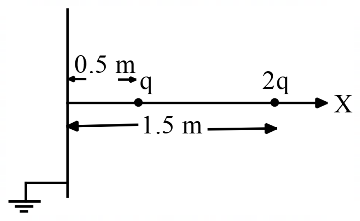Two charges q and 2q are placed along the X-axis in front of a grounded, infinite conducting plane, as shown in the figure. They are located respectively at a distance of 0.5 m and 1.5 m from the plane. The force acting on the charge q is

A. $$\frac{1}{{4\pi {\varepsilon _0}}}\frac{{7{q^2}}}{2}$$
B. $$\frac{1}{{4\pi {\varepsilon _0}}}2{q^2}$$
C. $$\frac{1}{{4\pi {\varepsilon _0}}}{q^2}$$
D. $$\frac{1}{{4\pi {\varepsilon _0}}}\frac{{{q^2}}}{2}$$
Answer: Option A
A. $$\frac{2}{{{\mu _0}}}\left( {x{\bf{\hat i}} + y{\bf{\hat j}}} \right)$$
B. $$ - \frac{2}{{{\mu _0}}}\left( {{\bf{\hat i}} + {\bf{\hat J}}} \right)$$
C. $$ - \frac{2}{{{\mu _0}}}\left( {{\bf{\hat i}} - {\bf{\hat j}}} \right)$$
D. $$\frac{2}{{{\mu _0}}}\left( {x{\bf{\hat i}} - y{\bf{\hat j}}} \right)$$
A. 0.033 μm
B. 0.330 μm
C. 3.300 μm
D. 33.000 μm
A. $${\bf{\hat z}}k$$
B. $${\bf{\hat x}}k\sin \alpha + {\bf{\hat y}}k\cos \alpha $$
C. $${\bf{\hat x}}k\cos \alpha + {\bf{\hat y}}k\cos \alpha $$
D. $$ - {\bf{\hat z}}k$$
A. vp = vg
B. vp = $${\text{v}}_{\text{g}}^{\frac{1}{2}}$$
C. vp vg = c2
D. vg = $${\text{v}}_{\text{p}}^{\frac{1}{2}}$$

Join The Discussion